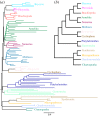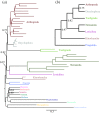Revisiting metazoan phylogeny with genomic sampling of all phyla
- PMID: 31288696
- PMCID: PMC6650721
- DOI: 10.1098/rspb.2019.0831
Revisiting metazoan phylogeny with genomic sampling of all phyla
Erratum in
-
Correction to 'Revisiting metazoan phylogeny with genomic sampling of all phyla'.Proc Biol Sci. 2019 Nov 6;286(1914):20191941. doi: 10.1098/rspb.2019.1941. Epub 2019 Nov 6. Proc Biol Sci. 2019. PMID: 31690235 Free PMC article. No abstract available.
Abstract
Proper biological interpretation of a phylogeny can sometimes hinge on the placement of key taxa-or fail when such key taxa are not sampled. In this light, we here present the first attempt to investigate (though not conclusively resolve) animal relationships using genome-scale data from all phyla. Results from the site-heterogeneous CAT + GTR model recapitulate many established major clades, and strongly confirm some recent discoveries, such as a monophyletic Lophophorata, and a sister group relationship between Gnathifera and Chaetognatha, raising continued questions on the nature of the spiralian ancestor. We also explore matrix construction with an eye towards testing specific relationships; this approach uniquely recovers support for Panarthropoda, and shows that Lophotrochozoa (a subclade of Spiralia) can be constructed in strongly conflicting ways using different taxon- and/or orthologue sets. Dayhoff-6 recoding sacrifices information, but can also reveal surprising outcomes, e.g. full support for a clade of Lophophorata and Entoprocta + Cycliophora, a clade of Placozoa + Cnidaria, and raising support for Ctenophora as sister group to the remaining Metazoa, in a manner dependent on the gene and/or taxon sampling of the matrix in question. Future work should test the hypothesis that the few remaining uncertainties in animal phylogeny might reflect violations of the various stationarity assumptions used in contemporary inference methods.
Keywords: animal phylogeny; compositional bias; matrix recoding; phylogenomics; taxon sampling.
Conflict of interest statement
We declare we have no competing interests.
Figures





References
-
- Wanninger A. 2016. Twenty years into the ‘new animal phylogeny’: changes and challenges. Org. Divers. Evol. 16, 315–318. (10.1007/s13127-016-0277-3) - DOI
-
- Giribet G. 2016. New animal phylogeny: future challenges for animal phylogeny in the age of phylogenomics. Org. Divers. Evol. 16, 419–426. (10.1007/s13127-015-0236-4) - DOI
Publication types
MeSH terms
Associated data
LinkOut - more resources
Full Text Sources
Other Literature Sources
Miscellaneous

